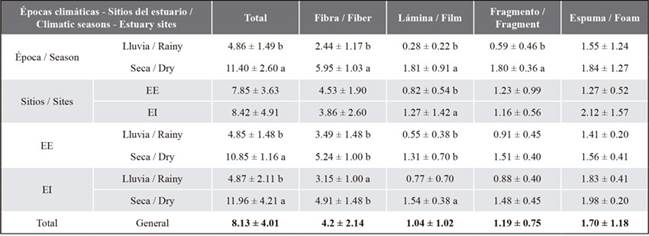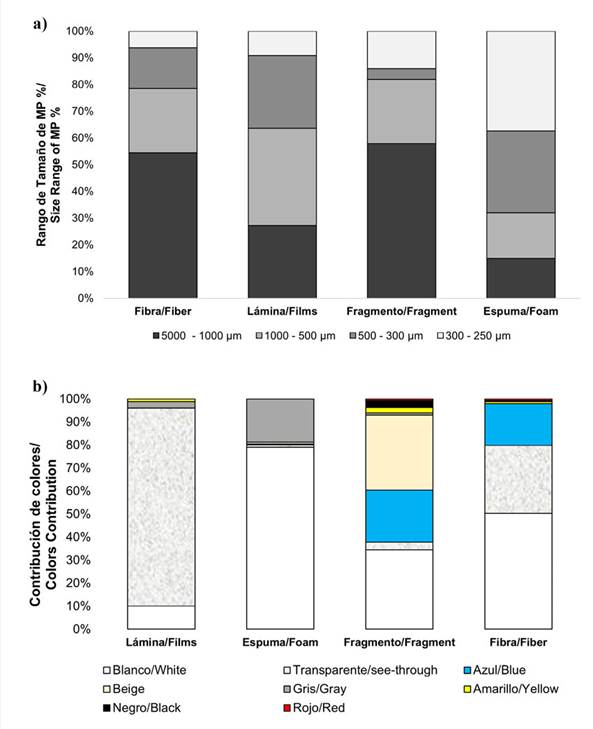INTRODUCTION
The oceans provide energy, food, recreation, and tourism (Avendaño et al., 2019; Usman et al., 2020). However, there is significant concern about the pollution caused by plastics that potentially impact marine life, trophic networks, and the ecosystem services provided by these environments (Hitchcock, 2020; Haddout et al., 2021). Since the creation of plastic by Leo Baekeland in 1907, this material has become the third most manufactured product in the world after steel and cement (Coe and Rogers, 1997; Williams and Rangel-Buitrago, 2019; Rangel-Buitrago et al., 2021), with an increase in production from 1.7 million tons to approximately 360 million tons per year from the 1950s to 2019 (Campos da Rocha et al., 2021).
Currently, plastic accounts for 60 to 80 % of marine debris and 90 % of floating particles on the surface of the seas (Daoud-Taha et al., 2021). This material is distributed locally and globally due to the influence of oceanographic dynamics, diffusion, and the physical characteristics of the polymers, including size, density, and shape, among others, enabling it to travel thousands of kilometers. Therefore, they accumulate in ocean gyres, on the seabed, in coastal ecosystems, and in remote areas, increasing pollution levels (Anderson et al., 2018; Acosta-Coley et al., 2019; Garcés-Ordóñez et al., 2020, 2021; Chen et al., 2021; Haddout et al., 2021; Simantiris and Avlonitis, 2022).
It has been recognized that, in marine environments, there are plastic particles <5 mm in diameter, known as microplastics (MPs) (Jones et al., 2020; Xia et al., 2020), classified according to their origin into primary and secondary categories. Primary MPs are manufactured directly by the industry to be used as raw material for other products. Secondary MPs originate from the fragmentation of larger plastic items, due to the action of environmental factors such as solar radiation, oxidation, and biodegradation (Garcés-Ordóñez et al., 2021; Rostami et al., 2021). The main sources of these MPs are urban runoff and domestic and industrial wastewater (Hitchcock, 2020).
Indeed, since most plastics are manufactured from non-biodegradable monomers derived from fossil hydrocarbons (Solís, 2022), they can remain for thousands of years (Xia et al., 2020; Issac and Kandasubramanian, 2021), increasing pollution levels. These MPs can also adsorb and transport heavy metals and other persistent organic pollutants (Chen et al., 2021; Galgani and Loiselle, 2021; Senathirajah et al., 2021), in addition to providing a new substrate for microbial communities to thrive (Galgani and Loiselle, 2021; Lobelle et al., 2021).
In marine organisms, when MPs are ingested, they can cause obstructions in the digestive tract, malnutrition, or bioaccumulation (Wright et al., 2013; Chen et al., 2021). This risk can also negatively affect humans (Issac and Kandasubramanian, 2021), as they are the end consumers of marine-derived foods (Saha et al., 2021). Indeed, it is suggested that humans may be ingesting up to 5 g of MPs per week (Chen et al., 2021; Senathirajah et al., 2021), and various studies have evidenced the presence of MPs in drinking water, bottled water, and sea salt (Issac and Kandasubramanian, 2021; Ragusa et al., 2021; Rostami et al., 2021; Shen et al., 2021; Zhang et al., 2021). Thus, MPs play a significant role as vectors of biological and chemical pollutants within trophic networks, including humans (Carbery et al., 2018; Caruso, 2019; Vidal et al., 2021).
Tumaco Bay is an estuary susceptible to this type of pollution, showing considerable abundances of MPs in its coastal surface waters (Garcés-Ordóñez et al., 2021), similarly to Buenaventura Bay (Vásquez-Molano et al., 2021; Vidal et al., 2021). Both regions host the largest human populations on the Pacific coast, and there is a significant production of wastewater and solid waste that could affect benthic communities, macroinvertebrates, and fish due to the ingestion of MPs (Gallego, 2018; Tafurt et al., 2020; Vásquez-Molano et al., 2021). In light of this, estuaries are of interest for the study of MPs as they act as a means for this contaminant material to enter marine environments from continental waters (Vidal et al., 2021). Therefore, the aim of this study was to determine the spatial-temporal influence of environmental variables and the distance from pollution sources on the distribution, accumulation, and type of MPs in Tumaco Bay (Colombian Pacific). These results are relevant for assessing the impacts and environmental effects on the ecosystem and for designing mitigation strategies.
METHODOLOGY
Study area
This research was conducted in Tumaco Bay, located at the southern end of the Colombian Pacific coast (1º 45’ N - 2º 00’ N, 78º - 78º 45’ W), covering an approximate area of 350 km² and depths ranging from 0 to 50 m. This bay (Figure 1) exhibits a semidiurnal tidal regime with a maximum amplitude of 4 m and is made up by a hydrographic network of important tributaries from the Pacific basin, among which the Rosario, Mira, and Patía rivers stand out. This fact makes the bay’s hydrography intricate and the sedimentary contributions it receives significant (Morales, 2003; Tejada, 2003; Salgado and Peña, 2016).
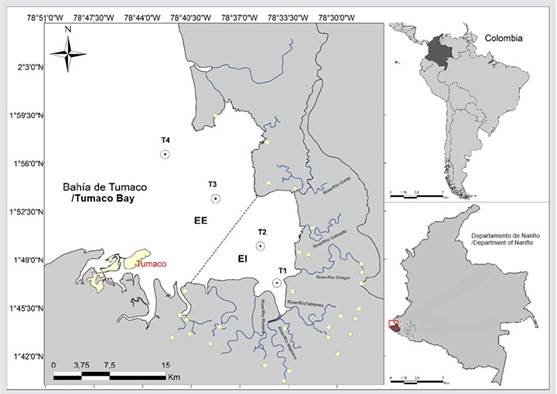
Figure 1 Tumaco Bay, department of Nariño, Colombian Pacific. Sampling sites, EI: Internal Estuary (sampling points T1 and T2), EE: External Estuary (sampling points T3 and T4). Populated centers ○ and tributary rivers ~.
Tumaco Bay is characterized by a humid tropical climate with abundant rainfall, primarily influenced by the Intertropical Convergence Zone (ITCZ). Precipitation begins at the start of the year, continuing until May. Between June and July, the area undergoes a transition from a wet to a dry season, during which rainfall gradually decreases, which ranges oscillating between 150 and 200 mm/month. The dry season is from August to November, with averages between 50 and 100 mm/month. December-January is a transition period (from dry to wet), during which rainfall significantly increases (Morales, 2003; Tejada-Vélez et al., 2003; García, 2009).
Field phase
Surface water sampling in Tumaco Bay was carried out in February 2020 (rainy season), with an average flow of 950 m³/s and an average precipitation of 270.64 mm, and in October 2020 (dry season), with an average flow of 630 m³/s and an average precipitation of 132.42 mm (IDEAM, 2020). The sampling sites were selected according to the environmental gradient generated by the river mouths and their proximity to potential pollution sources, such as populated centers. Two sites within the bay were defined: the Internal Estuary (IE) (1°50’34” N - 78°33’24.2” W), which experiences the highest anthropogenic pressure, as it is located near the mouth of rivers and estuaries as well as municipal districts, and the External Estuary (EE) (1°57’53.9” N-78°39’27.9” W), which has a greater marine influence (Figure 1).
Starting with sampling at IE and concluding at EE, surface water was collected at four stations for each season, one for each defined site, composed of three replicates, for a total of 24 samples collected. To this effect, a 250 µm horizontal trawl net with an opening diameter of 29.5 cm was used.
Considering some methodologies, the trawls were conducted parallel to each other, at a distance of 490.7 ± 128.1 m, with a duration of 10 min, at a constant speed of 4 km/h, and a waiting time of 30 min between sampling points (Reisser et al., 2019; Kerubo et al., 2020; Schöneich-Argent et al., 2020). After each trawl, the net was checked for clogging, which never occurred as there was minimal suspended material. The net was then rinsed with filtered sea water, and the retained material was transferred to clean 500 ml glass containers and refrigerated at a temperature of 4 °C.
At the same time, environmental variables such as salinity, TDS, and transparency were measured in the water at a depth of 50 cm using a YSI 556 MPS multiparameter probe (Duque et al., 2020; Molina, 2020). Daily precipitation records and monthly flow data were provided and obtained from the Granja El Mira and San Juan Mira meteorological stations, respectively, which are located near the sampling site (IDEAM, 2020). There were favorable weather conditions (partially sunny) during sampling, with no atypical wave conditions, which remained uniform throughout the process.
Laboratory phase
To treat the MP samples, the methodologies proposed by Masura et al. (2015), INVEMAR (2017), and Vidal et al. (2021) were considered. First, sieving was conducted using two stainless steel filters with diameters of 5 mm and 0.125 mm in order to separate the particles, retaining only those caught in the 0.125 mm filter. Then, the material from each sample was transferred into beakers with distilled water and dried at 60 °C for 24 h or until complete drying.
Subsequently, 30 to 50 ml of 10 % sodium hypochlorite were added to oxidize the organic matter, allowing it to sit for 24 to 48 h. Once the oxidation time was complete and the organic matter was no longer visible, the sodium hypochlorite was removed with distilled water.
Once the 5M sea salt solution had been prepared (6 g of salt for every 20 ml of sample), the material and the saline solution were transferred to a density separator and left to rest for an hour. With the solids separated, those that settled were drained, ensuring that no MPs were present. As for the floating and suspended solids, they were left in distilled water for 30 minutes to reduce the salt concentration in the samples. Finally, the clean material was transferred to Petri dishes using distilled water and placed in an oven at 60 °C for 24 h or until complete drying.
As for the identification of MPs, the methodology proposed by Lusher et al. (2017) was followed. The previously dried material was inspected using a Motic SMZ - 168 Series 5X stereoscope, and heat resistance was evaluated by bringing a hot needle close to the material and observing any deformations, marks, or perforations, as plastic pieces melt or deform. According to the classification proposed by Viršek et al. (2016), the types of MPs were categorized as fibers, films, fragments, and foams. Their sizes were classified between 250 and 5000 µm, as measured with a ZEISS AxioCam microscope, and the color characteristics were classified via observation.
Quality control
To avoid contaminating the samples, preventive measures were implemented during the analysis. The work surface area was thoroughly cleaned with 70 % ethanol before starting sample processing, glass and stainless-steel instruments were used throughout the work, each beaker was covered with aluminum, and cotton lab coats and nitrile gloves were worn. Similarly, the sampling equipment, filtration devices, and tools used were washed with distilled water. Finally, three blanks (Petri dishes with distilled water) were placed in the work area, in which the presence of MPs was not observed (Prata et al., 2021; Zhang et al., 2021).
Statistical analysis
The differences between data groups were evaluated using Permutational Multivariate Analysis of Variance and post hoc tests, the Permanova pair-wise test, with Euclidean distances and data transformed with (ln (x + 1)). The p(PERM) and (MC) significance values were calculated from 9,999 permutations, taking α < 0.05 as a statistically significant difference. Additionally, a two-way similarity percentages (Simper) analysis with Euclidean distances and data transformed with (ln (x + 1)) was used to assess the similarity in the abundance of MP types between climatic seasons and study sites, in order to identify the spatial-temporal dynamics of MPs. This was done using Primer 7 (Anderson, 2017). Finally, a univariate GAM (Generalized Additive Models) analysis was performed using RStudio (R Core Team, 2013), as a method to explore the influence of some environmental variables on the abundance of MPs.
RESULTS
Abundance and distribution of microplastics
The types of MPs found in Tumaco Bay corresponded to fibers, fragments, foams, and films (Figure 2). The average abundance of MPs in the bay was 8.13 ± 4.01 items/m³ (average ± standard deviation) (range: 3.37 - 11.66 items/m³), with fibers being the most abundant at 4.20 ± 2.14 items/m³ (53.8 %), followed by foams with 1.70 ± 1.18 items/m³ (19.2 %), fragments with 1.19 ± 0.75 items/m³ (14.4 %), and films with 1.04 ± 1.02 items/m³ (12.3 %).
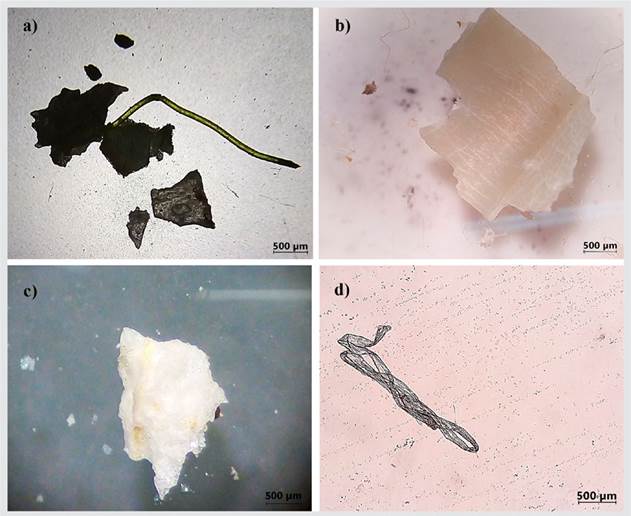
Figure 2 Types of microplastics found in surface water samples from Tumaco: a) fiber and fragments, b) fragment, c) foam, and d) film.
In general, the abundance of MPs was significantly different between climatic seasons (p(PERM) = 0.002) across the bay, evidencing a higher abundance during the dry season (11.40 ± 2.59 items/m³) compared to the rainy season (4.86 ± 1.49 items/m³). It is worth noting that fibers were the predominant MP group in both seasons, accounting for 54.1 % in the dry season (5.95 ± 1.03 items/m³) and 53.5 % in the rainy season (2.44 ± 1.17 items/m³). On the other hand, the Simper analysis suggested that films were the MP type that contributed the most to the differences in the distribution between climatic seasons (56.77 %).
Additionally, a higher abundance of MPs was observed in the IE (8.42 ± 4.91 items/m³) compared to the EE (7.85 ± 3.63 items/m³), with no significant differences (p(PERM) = 0.34) (Table 1). As with the climatic seasons, fibers were the predominant MP group in both estuary sites, with 47.9 % in IE (3.86 ± 2.59 items/m³) and 59.8 % in EE (4.53 ± 1.90 items/m³). Films reported the greatest contribution (41.51 %) to the differences in distribution between the estuary sites according to the Simper analysis.
The interaction between climatic seasons and estuary sites was significant (p(PERM) = 0.02). In fact, a variation in the quantity of MPs was observed according to this interaction (Table 1). In the rainy season, the abundance of MPs was higher in the outer portion (56.8 %), whereas, during the dry season, the abundance was higher in the inner portion (52.7 %). Finally, fibers showed significant differences between seasons and regarding the season-site interaction; films did so between seasons, sites, and the season-site interaction; and fragments showed differences between seasons.
Environmental variables
The average data obtained for the precipitation variable (Figure 3a) showed no statistical differences. Salinity (Figure 3b) and TDS (Figure 3c) showed linear relationships and significant differences between sites (EE and IE).
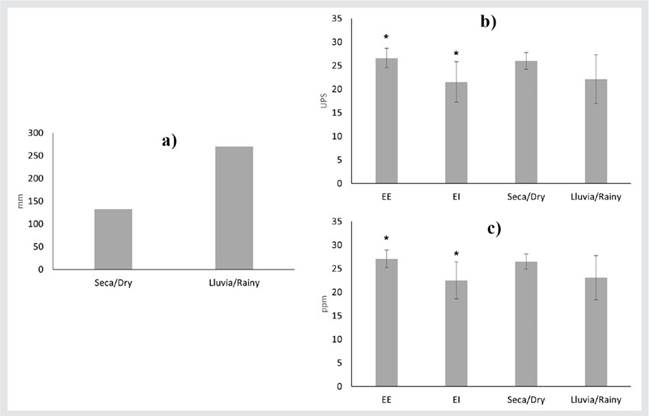
Figure 3 Data from the Granja El Mira meteorological station in Tumaco Bay (2020). a) Average annual precipitation. b) Average salinity. c) Average total dissolved solids (TDS).
No significant relationships between MP abundance and transparency were recorded in the estuary. GAM analyses revealed that the concentrations of films and fragments were directly and significantly correlated with precipitation, as well as with the total MPs (Table 2). Additionally, the concentrations of fibers were directly correlated with both salinity and total dissolved solids (TDS) (Table 2). It is worth noting that some of the highest MP concentrations were recorded in association with high salinities.
Color and size
In general, the average size of the MPs found was 1,001 μm, specifically for fibers (1,417.78 ± 251.2 μm), foams (625.83 ± 257.9 μm), fragments (915.38 ± 254.8 μm), and films (1,045.21 ± 454.6 μm). More than 50 % of the MPs were recorded within a size range of 250 to 1,000 μm (Figure 4a). On the other hand, three predominant colors were found: white (48.6 %), transparent (27.2 %), and blue (13.1 %), followed by beige (4.9 %), gray (4.1 %), yellow (0.96 %), black (0.72 %), and red (0.43 %) (Figure 4b). It is important to note that, during the rainy season, a greater variety of colors appeared in the identified MPs, unlike in the dry season.
DISCUSSION
Due to their dynamics, estuarine systems accumulate a greater number of MPs in comparison with oceans, which is why they have been documented as hotspots of plastic pollution and as sources of MPs for marine environments (Alfonso et al., 2021; Shi et al., 2022; Wei et al., 2023). In this case, the average concentration of MPs in Tumaco Bay (8.13 items/m³) falls within a range similar to other environments characterized by strong anthropogenic activities and plastic inputs, as is the case of the estuary of the Chao Phraya River in Thailand, where average MP concentrations of 5.16 items/m³ were recorded (Oo et al., 2021), and the Gulf of Mexico, a semi-enclosed sea receiving discharges from the Mississippi, where variations between 5.0 - 18.4 items/m³ of MPs were found (Mauro et al., 2017).
At a local level, the concentrations were above those recorded in Buenaventura, with 2.80 items/m³ (Vidal et al., 2021), and Tumaco, with 0.06 - 2.99 items/m³ of MPs (Garcés-Ordóñez et al., 2021), during the transition period of 2017, suggesting a high level of pollution and an increased MP concentration within the estuary. Additionally, the results were compared against those of similar sampling methods (Table 3), considering that recent research agrees that the size of the mesh controls both the quantity and size of the collected microplastics (Lindeque et al., 2020; Skalska et al., 2020; Aigars et al., 2021; Zheng et al., 2021).
Table 3 Abundance of microplastics present in marine waters in different parts of the world, averages ± standard deviation (maximums).
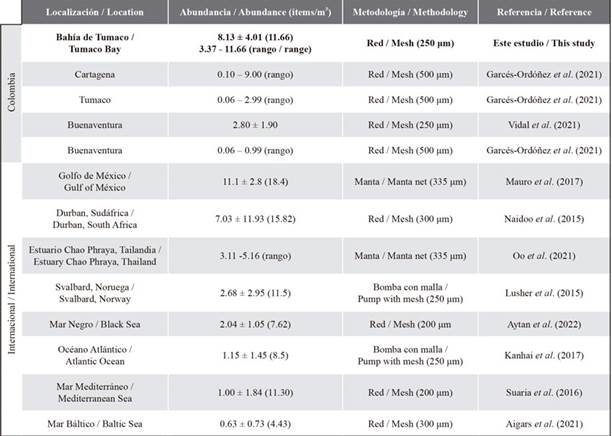
The high abundance of MPs during the dry season could be related to variations in the flow regime, due to a decrease in the amount of water entering the bay, as indicated by the flow records of the Mira River (the main tributary of the estuary). The low current speed and shallow depth can extend the residence time of MPs, leading to a greater accumulation in the estuary area (Wicaksono et al., 2021).
Similarly, resuspension events facilitate the transfer of MPs from the sediments to the water column, as the water dynamics in the bay are strongly influenced by tides (Díaz-Merlano et al., 2007), leading to an increased concentration in surface waters during the dry season. Moreover, due to their low density, synthetic polymers such as polyethylene and polypropylene, which are more frequently used in the production of non-fiber plastics, concentrate in the water column, resulting in their agglomeration (Preciado and Zapata, 2020; Li et al., 2021).
Likewise, during the dry season, the drag force of water entering from the rivers decreases, leading to a lower dispersion of MPs. In fact, it has been demonstrated that turbulent bursts can trigger the transient drag of particles, especially smaller ones, as they are small enough to be more susceptible to alterations in hydrodynamic processes, easily transferring to the water column (Zhang, 2017; Xia et al., 2021). This explains why more than 50 % of the MPs are found in size ranges <1000 μm. Furthermore, these hydroclimatic variations might explain why a greater accumulation of MPs was observed in the outer portion during the rainy season and in the inner portion during the dry season in the bay. These differences in the accumulation and movement of MPs are of special interest because ‘old MPs’ can be reactivated and often contain more toxic substances than ‘fresh’ ones (Xia et al., 2021).
On the other hand, the higher abundance of MPs in the inner portion (IE) of the estuary could be explained by its exposure to the river and stream mouths, as well as to municipal rural subdivisions like Punto Tibio, Robles, El Retoño, Rosario, Gualajo, Bernardino Ortiz, and Las Sirenas. These rural areas amount to more than 93 thousand inhabitants, showing rapid and disorganized population growth that has brought about pollution issues (Tejada-Vélez et al., 2003; Alcaldia de Tumaco, 2019; Hitchcock and Mitrovic, 2019; Defontaine et al., 2020).
In turn, the bay is subject to strong anthropogenic intervention, in the form of industrial, domestic, and port activities, in addition to the improper management and disposal of household solid waste and wastewater (Tejada-Vélez et al., 2003; Correa et al., 2016), given that that 35 % to 40 % of the solid waste and 50 % of the liquid waste generated are directly dumped into the sea, leading to significant inputs of debris such as nets, nylon, and plastics, among others (CCO, 2008). Considering that the inhabitants of Tumaco base their economy on extraction activities such as fishing, which takes place in areas close to the communities’ habitat, and that artisanal fishermen are the main suppliers of the fish processing industry, with 22 associations comprising about a thousand artisanal fishermen (Sánchez-Gutiérrez, 2012), the local population and the estuarine ecosystems are vulnerable to the environmental issues generated by MPs.
The spatial-temporal distribution of MPs in the marine environment is a complex issue correlated with several factors, including oceanography, climate, the physical and chemical properties of the MPs, and biological processes (Jiang et al., 2020). In this study, the abundance of MPs was related to salinity, precipitation, and TDS. A positive correlation was observed between the abundance of fibers and salinity, suggesting that salinity, by increasing water density, plays a significant role in the distribution of MPs.
Plastic materials have varying densities, typically ranging from 0.04 to 1.58 g/cm3, which is to say that a higher salinity results in a greater buoyancy force, and therefore in an increased accumulation of MPs in surface waters (Jiang et al., 2020). This can particularly affect fibers, which have higher surface-to-volume ratios, giving them greater buoyancy. In combination with high salinity concentrations, this would increase drag forces and the time on the water’s surface, in addition to reducing the settling speeds in the sediment. This could also explain why fibers had a proportional distribution throughout the estuary and were the most abundant type of MP, besides other factors such as the discharge of domestic wastewater containing fibers, maritime transport activities, fishing activities, and surface runoff (Alfonso et al., 2021).
This study also found a direct relationship between fibers and TDS. Similar research works have shown correlations between the abundance of MPs and TDS (Ibeto et al., 2021; Sari et al., 2021). This association could be due to the sedimentation-resuspension interaction, increasing MP concentrations in sediments during the rainy season (Dhineka et al., 2022; Jeyasanta et al., 2023; Martínez, 2023) due to the adherence of TDS to MPs, which increases the MPs size and density and improves their sedimentation rate (Barros, 2021; Buwono et al., 2021; Gupta et al., 2021).
On the other hand, during the dry season, the MPs immobilized in the sediment can be reactivated by disturbances at the water-sediment interface, accumulating in surface water and decreasing the number of MPs in the sediments (Lafabrie et al., 2013; Zhang et al., 2020; Martínez, 2023), given that, as argued by Xia et al. (2021), smaller and less dense particles like MPs show more resuspension events when compared to larger ones, facilitating the transfer of microplastics from sediment to water. In addition, buoyancy is reduced by precipitation because the salinity of the water column decreases, thus increasing the sinking rate and possibly allowing more particles to reach the bottom. Conversely, during the dry season, estuarine waters are characterized by higher salinity, which could reduce the sedimentation rates of the particles and cause a lower MP concentration in the sediment (Gupta et al., 2021). Therefore, sediments could be acting as both a sink and a source of MPs (Dalu et al., 2021).
The direct relationship between precipitation and films, fragments, and total MPs could be because rainwater carries waste from the ground through runoff, which would contribute to the entry of these MPs into the estuary (Bailey et al., 2021; Werbowski et al., 2021). Similarly, it has been shown that a high precipitation increases the deposition of atmospheric MPs due to the binding of atmospheric MPs to rainwater particles, which is to say that the greater the precipitation, the more MPs are deposited (Ferrero et al., 2022; Purwiyanto et al., 2022).
Most of the MPs found were within a size range of 250 to 1000 μm. This could be due to the fact that smaller MPs are easily transported and tend to mix with the water and distribute evenly across its different layers. On the other hand, larger MPs primarily float on the water’s surface. This reduces the accumulation effects of small particles when compared to larger ones (He et al., 2021).
Regarding the colors found in the surface water samples, white, transparent, and blue were predominant. White is generally an indication that the source polymer type might have been polyethylene. Likewise, this color indirectly signals the degradation process taking place at the site over a long period, transforming other colored contents into white, indigestible by aquatic biota (Kosore et al., 2018; Bharath et al., 2021). The yellowish color of the MPs can also indicate the process of photooxidation and weathering of these particles (Choong et al., 2021; He et al., 2021; Wicaksono et al., 2021).
Transparent MPs are generally associated with polypropylene, which is commonly used in food packaging materials, while blue is linked to materials and activities related to fishing or textiles. The color of microplastics is important, as it can provide insights to predict the source and the weathering process of MPs (Choong et al., 2021; He et al., 2021; Wicaksono et al., 2021).
The results found in this study, in addition to demonstrating a high level of pollution in Tumaco Bay, contrast with the spatial-temporal variation recorded in similar studies in Buenaventura, where there was a higher concentration of MPs during the rainy season and in the outer area of the estuary. This evidences how the different dynamics within these environments, as well as the sources of contamination, specifically condition MP concentrations on the superficial water of each bay. It is worth considering that the methodologies for processing MPs vary between studies, which limits comparisons regarding the size range and the quantity of MPs found.
CONCLUSIONS
In general, Tumaco Bay exhibits high levels of pollution and an increased MP concentration within the estuary. During the rainy season, a greater abundance is observed in the outer part, whereas, in the dry season, a higher abundance is evident in the inner portion due to the reduction in the amount of water entering the bay.
Fibers were the most abundant type of MPs (53.89 %), probably because they are characterized by a greater buoyancy. It was determined that the MP density and type of MP were related to the environmental variables, demonstrating that salinity, TDS, and precipitation influenced MP abundance and/or accumulation. This is due to the fact that the dynamics of the climatic seasons cause increases in water density during the dry season and a decrease during the rainy season, which probably produces, along with the MP size, mobilization and settlement in surface waters. This, in addition to atmospheric deposits and runoff, external factors that contribute to an increase in MPs.
Most MPs were found in the size range of 250 to 1000 μm, and white, blue, and transparent were the predominant colors, providing relevant information for determining the source and the weathering process.











 text in
text in 


